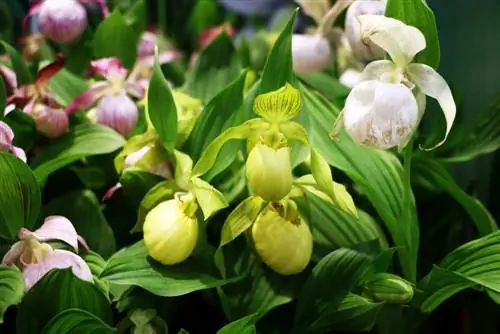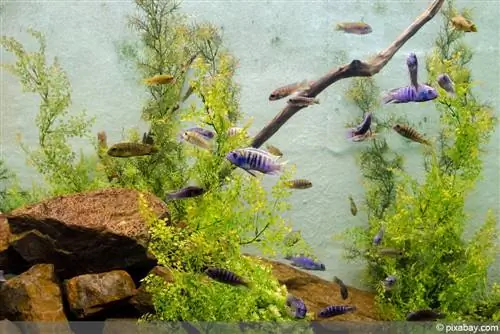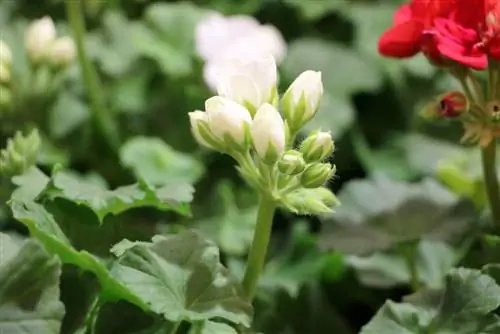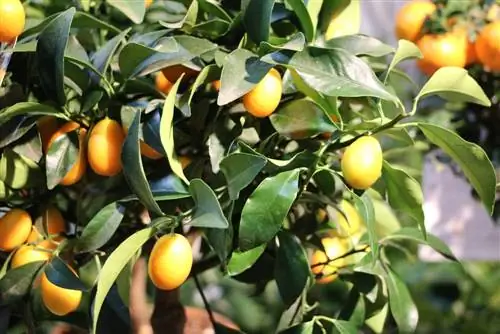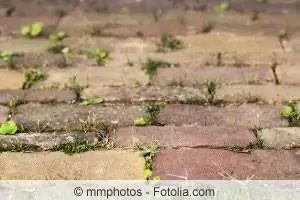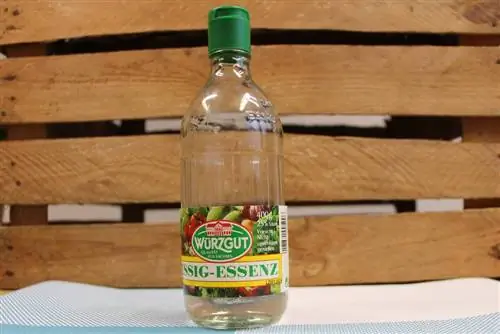- Author admin [email protected].
- Public 2023-12-17 03:39.
- Last modified 2025-01-24 12:45.
These unique plants combine many positive properties. This particularly applies to their beautiful flowers, with different colors and colorings and flower shapes. Specimens of the genus Phalaenopsis are most commonly found. But they can only develop their full splendor with the right fertilizer. Fertilizing mistakes can lead to a lack of flowering or even the loss of the orchid.
Orchid fertilizer vs. home remedies
When it comes to orchids, a distinction is made between terrestrial species, i.e. those that grow in the ground, and epiphytic species, which grow in the wild as so-called epiphytes.i.e. they grow on trees or other plants. In order to provide orchids with everything they need to thrive, only a few nutrients are usually necessary.
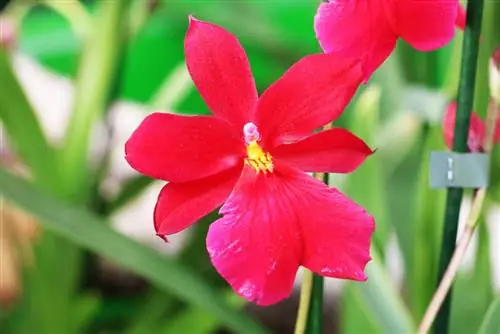
In nature, they absorb water and nutrients through the air and rain. Houseplants need to be given the appropriate fertilizer. This requires a lot of sensitivity in choosing the right fertilizer and in the dosage, because you should neither fertilize too much nor too often. Too much fertilizer or the s alts contained in many fertilizers can quickly burn the roots and severely damage the plants.
Only if major errors in watering and fertilizing are avoided can these elegant exotic plants thrive and continually present their magnificent flowers. While you should only use soft water, i.e. rainwater, for watering, it is not easy to find the right one given the large number of fertilizers available on the market. In addition, there is often talk of various home remedies that are said to be suitable for fertilizing. But which fertilizer is the best?
Home remedies for fertilizing orchids
As an alternative to commercially available orchid fertilizers, there are a wide variety of experiences and opinions circulating about home remedies that are said to have a similar effect as special fertilizers. However, the effectiveness of these sometimes bizarre remedies is controversial and, in the worst case, could do more harm than good to the plants.
Coffee grounds
Coffee grounds are known to be a very good fertilizer. But does this also apply to orchids? In addition to the main nutrients potassium, phosphorus and nitrogen, coffee grounds also contain a variety of minerals. Most plants can definitely do something good with this 'waste product'. On the other hand, you should be a little more careful with orchids, because they are very sensitive houseplants.
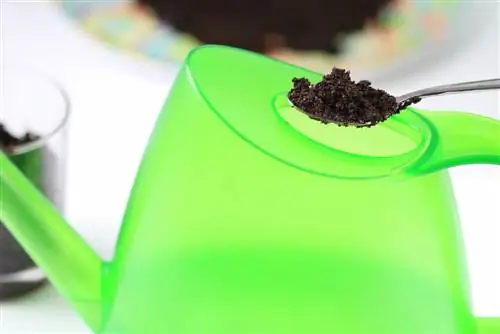
To avoid damage, it is advisable to first try out whether and how the orchids tolerate the coffee grounds. To do this, you can mix about a teaspoon of dried grounds into the substrate and then wait a few days to see what happens. Alternatively, you can water the orchids with coffee water. Coffee water is obtained, for example, by diluting coffee residues with water. If the plants cope well with this and there are no changes in the following days, you can water the orchids alternately with coffee water and normal rainwater.
Tip:
The use of coffee grounds is ideal for terrestrial orchids, i.e. growing in soil. These include Cymbidium orchids, the best-known representative of which is the lady's slipper.
Black Tea
If you don't like coffee and prefer to drink tea, you can try black tea. The tea water is said to have a similar effect to coffee water.
- To do this, pour warm water over the leftover tea bags or loose tea
- Add approximately 250 ml of water to the contents of one tea bag
- Ideally use lime-free or low-lime water
- Let the whole thing steep for about 20 minutes
- Then pour the liquid through a sieve or remove the tea bag
- Tea water is now ready to pour
- Always prepare watering water fresh if possible
Yeast water
Yeast as a fertilizer is relatively unknown and somewhat suspect. It is said to contain, among other things, potassium and phosphorus and thus strengthen the resistance of orchids. Dry yeast should contain around 60% nitrogen and is therefore particularly suitable for fertilization. In order to use the yeast as fertilizer, crumble a cube of yeast in 10 liters of lukewarm water and stir the whole thing until the yeast has completely dissolved.
With this yeast water you can water the orchids 1 - 2 times a month before and during flowering. It's best to test carefully first to see whether the orchids can actually tolerate this brew, although this type of fertilization would probably also be more suitable for terrestrial orchids.
Commercial orchid fertilizers
A variety of fertilizers specifically for orchids are available in stores. They all have the advantage that they are tailored to the specific needs of these plants and contain all the important nutrients. In contrast to other plant fertilizers, such as flowering plant or houseplant fertilizers, orchid fertilizers have a significantly lower dosage. Because even in their natural habitat, these fascinating plants thrive with a rather limited supply of nutrients. Orchid fertilizers are available in the form of liquid fertilizers, fertilizer sticks or as fertilizer sprays.
Liquid fertilizer
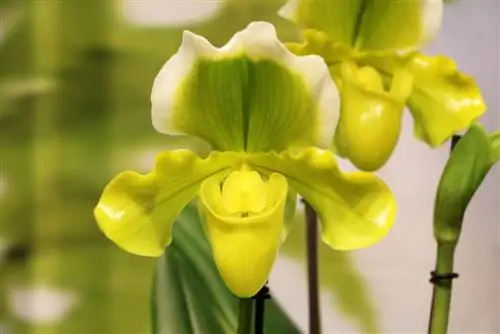
Liquid fertilizer has the decisive advantage over solid fertilizers, for example in the form of fertilizer sticks, that it is easier to dose and can be distributed better and more evenly in the substrate. Subsequent watering is not necessary. You can add it directly to the irrigation water and water the orchids with it, or you can mix it with water and give the orchids a dip for a few minutes. Liquid fertilizer should always be shaken well before use and the immersion water should be stirred well before diving.
Tip:
Some manufacturers offer these orchid liquid fertilizers in containers that have an automatic return. This comes into play when too much pressure is exerted when removing fertilizer, so that precise removal is possible and over-fertilization is prevented.
Fertilizer sticks
Most orchids that are kept as houseplants are grown in a special, coarse-textured substrate, usually pine bark. The roots of the orchids find support there and the good ventilation means their oxygen needs can be optimally met. Fertilizer sticks cannot dissolve and distribute optimally in these substrates, so that only a selective and not a uniform supply of nutrients is possible.
The nutrient concentration is very high around the sticks, which can damage the sensitive roots. While the nutrient content in these places is very high, in others very little or no fertilizer reaches others. In addition, parts of the fertilizer sticks can fall through the substrate onto the bottom of the pot and collect there, unusable for the plant.
Fertilizer Spray
Since orchids absorb nutrients through both their roots and leaves, using fertilizer sprays can be useful. As a rule, these ready-to-use sprays contain urea, which is often used as nitrogen fertilizer. With the exception of the flowers, the aerial roots and the top and bottom of the leaves are sprayed when fertilizing. Alternatively, you can put a low concentration of organic liquid fertilizer with lime-free water in a spray bottle and spray the orchids regularly.
Organic or mineral fertilizers?
When looking for the best fertilizer, you can choose not only between liquid and solid fertilizers, but also between organic and mineral ones. Organic fertilizers such as horn shavings, bone meal, garden compost or manure are completely unsuitable for these sensitive plants. For this reason, most orchid fertilizers available on the market are mineral fertilizers.
The nutrient composition of these fertilizers is adapted to the needs of these plants. They are available to you immediately and can be recorded directly. Another advantage over organic fertilizer is that defrost water with mineral fertilizer can be used several times without it tipping over. With organic fertilizers this happens much faster, so it has to be poured away relatively quickly.
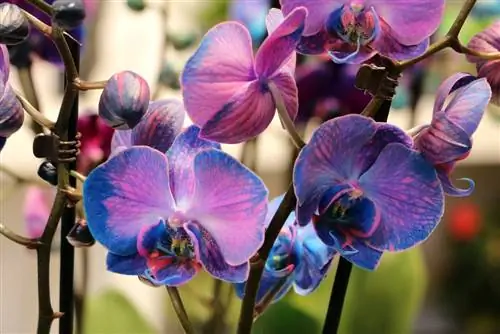
However, when dipping baths with mineral fertilizers, you should always pay attention to the water level in the dipping vessel. Depending on how much water evaporates during diving breaks, it must be refilled with fresh water. Otherwise the nutrients will accumulate too much. In addition to organic and mineral fertilizers, there is also a combination of both fertilizers. They combine the rapid nutrient effect of a synthetic fertilizer with the long-term nutrient release of an organic fertilizer.
Tip:
If you still prefer organic fertilizer for your orchids, you can make it yourself in the form of a so-called compost tea. Compost tea is also available in stores as a ready-made mixture.
Make your own compost tea
To make compost tea you need a larger container, lime-free water and leafy plant material. Ordinary garden compost is completely unsuitable. If necessary, old vegetable scraps such as cucumbers or tomatoes can also be added.
- First fill the respective container with lime-free water
- Then add the plant material
- One liter of water contains around 1 kg of material
- Then let the whole thing rest for about 24 hours
- Ambient temperatures of at least 20 degrees are good
- The warmer it is, the better
- The next day, pour the liquid through a sieve
- Then fill into a watering can or dipping tub
- Remaining plant residues can be used multiple times
- Covered, compost tea can be reused for a few weeks
- To strengthen the plants, water the orchids about every 2 - 3 weeks
Tip:
If that's too much effort for you, you can also buy ready-made compost tea. This is usually offered in the form of infusion bags and is therefore easy to handle and dose.
Which orchid fertilizer is the best?

Which orchid fertilizer is ultimately the best depends on various factors. On the one hand it is a matter of personal experience with one or another fertilizer, on the other hand the type of irrigation water and the substrate influence the choice of the right fertilizer.
Pine bark is usually used as a substrate for orchids grown in pots. The advantages of this substrate are primarily its structural stability and the ability to buffer mineral s alt solutions. To ensure that the bark is free of any germs, bacteria and fungi, it is advisable to first kill it in the oven at around 65 degrees.
When it comes to irrigation water, a distinction is made between hard and soft water (rainwater). The latter is free of any s alts. If watered exclusively with rainwater, which would be the ideal case, the fertilizer used should contain all important minerals, little ammonium nitrogen and no urea.
On the other hand, when using hard tap water, fertilizers that do not contain magnesium, calcium and sulfates are recommended. In any case, orchids should only be watered in exceptional cases with conventional tap water that has already been stale for a few days. In contrast to rainwater, the fertilizer here can contain slightly more nitrogen, depending on the hardness of the water.
In general, the fertilizer should be free of so-called chelates (EDTA). A pH value of 5.5 to a maximum of 6.5 is recommended. A balanced ratio of nitrogen N, phosphorus P and potassium K (10:8:10) is important. A commercially available universal fertilizer in this composition could easily be used to fertilize orchids all year round.
Conclusion
In conclusion, it can be said that home remedies such as those mentioned above are less suitable for fertilizing orchids, as are commercially available flower or houseplant fertilizers. Anyone who has had good experiences with home remedies can definitely continue to use them. If you want to supply your plants with all the important nutrients in the right nutrient composition, special orchid fertilizers in the form of liquid fertilizers are usually best suited.

